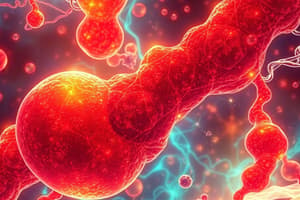Podcast
Questions and Answers
What is the primary product generated during each cycle of beta-oxidation?
What is the primary product generated during each cycle of beta-oxidation?
- Fatty Acyl-CoA
- Glycerol
- Carnitine
- Acetyl-CoA (correct)
Which fatty acid chain length requires activation by adding a CoA to enter the mitochondria?
Which fatty acid chain length requires activation by adding a CoA to enter the mitochondria?
- Very Long Chain (> 22C)
- Short Chain (2-4C)
- Medium Chain (5-11C)
- Long Chain (12-22C) (correct)
What is the role of Carnitine in fatty acid metabolism?
What is the role of Carnitine in fatty acid metabolism?
- It oxidizes fatty acids during beta-oxidation.
- It transports long-chain fatty acids into the mitochondria. (correct)
- It activates short-chain fatty acids.
- It converts Acetyl-CoA to fatty acids.
Which of the following statements accurately describes the process of activating long-chain fatty acids?
Which of the following statements accurately describes the process of activating long-chain fatty acids?
Which enzyme is primarily responsible for oxidizing Fatty Acyl-CoA during beta-oxidation?
Which enzyme is primarily responsible for oxidizing Fatty Acyl-CoA during beta-oxidation?
What initiates the process of fatty acid oxidation in the mitochondria?
What initiates the process of fatty acid oxidation in the mitochondria?
What happens to Carnitine after it has transported Fatty Acyl-Carnitine into the mitochondria?
What happens to Carnitine after it has transported Fatty Acyl-Carnitine into the mitochondria?
How many ATP equivalents are used during the activation of fatty acids?
How many ATP equivalents are used during the activation of fatty acids?
What is the primary energy source for brain cells?
What is the primary energy source for brain cells?
Which enzyme is the rate limiting step in the synthesis of ketone bodies?
Which enzyme is the rate limiting step in the synthesis of ketone bodies?
During a starvation state, what alternative does the brain adapt to use for energy?
During a starvation state, what alternative does the brain adapt to use for energy?
Where are ketone bodies synthesized in the body?
Where are ketone bodies synthesized in the body?
Which of the following ketone bodies is produced in the greatest amount?
Which of the following ketone bodies is produced in the greatest amount?
What process activates lipolysis and ketogenesis during starvation?
What process activates lipolysis and ketogenesis during starvation?
What is the role of CoA in the context of ketone body synthesis?
What is the role of CoA in the context of ketone body synthesis?
Why is ketone body synthesis significant during periods of low glucose availability?
Why is ketone body synthesis significant during periods of low glucose availability?
What is the primary energy source that decreases if the carnitine shuttle is disrupted?
What is the primary energy source that decreases if the carnitine shuttle is disrupted?
In the process of beta-oxidation, which of the following is NOT a product?
In the process of beta-oxidation, which of the following is NOT a product?
Which deficiency leads to the accumulation of Long Chain Fatty Acyl-CoAs?
Which deficiency leads to the accumulation of Long Chain Fatty Acyl-CoAs?
What is required for the thiolysis stage of beta-oxidation?
What is required for the thiolysis stage of beta-oxidation?
What occurs to fatty acids in the event of LCAD deficiency?
What occurs to fatty acids in the event of LCAD deficiency?
What fatty acid metabolism process is reliant on the transport of long-chain fatty acids into mitochondria?
What fatty acid metabolism process is reliant on the transport of long-chain fatty acids into mitochondria?
What is a common effect of an SCAD deficiency?
What is a common effect of an SCAD deficiency?
What condition is often associated with Medium Chain Acyl-CoA dehydrogenase deficiency?
What condition is often associated with Medium Chain Acyl-CoA dehydrogenase deficiency?
What is the primary function of acyl-CoA dehydrogenase in beta oxidation?
What is the primary function of acyl-CoA dehydrogenase in beta oxidation?
What role does FAD play in the beta oxidation process?
What role does FAD play in the beta oxidation process?
Which enzyme adds a hydroxyl group during the hydration step of beta oxidation?
Which enzyme adds a hydroxyl group during the hydration step of beta oxidation?
What is produced after the oxidation of 3-hydroxyacyl-CoA?
What is produced after the oxidation of 3-hydroxyacyl-CoA?
What is a key outcome of the thiolysis step in beta oxidation?
What is a key outcome of the thiolysis step in beta oxidation?
What prevents fatty acids from leaving the cell prior to their activation?
What prevents fatty acids from leaving the cell prior to their activation?
What is the first enzyme involved in the carnitine shuttle process?
What is the first enzyme involved in the carnitine shuttle process?
Which transport protein is responsible for crossing the inner mitochondrial membrane during the carnitine shuttle?
Which transport protein is responsible for crossing the inner mitochondrial membrane during the carnitine shuttle?
What role does isomerase play in the beta-oxidation of unsaturated fatty acids?
What role does isomerase play in the beta-oxidation of unsaturated fatty acids?
During beta-oxidation of saturated fatty acids, which enzyme is necessary in the initial step?
During beta-oxidation of saturated fatty acids, which enzyme is necessary in the initial step?
What are the three main functions of peroxisomes?
What are the three main functions of peroxisomes?
Which statement best describes beta-oxidation in polyunsaturated fatty acids?
Which statement best describes beta-oxidation in polyunsaturated fatty acids?
What occurs to very long chain fatty acids in peroxisomes?
What occurs to very long chain fatty acids in peroxisomes?
What is the primary energy substrate utilized during fasting or starvation?
What is the primary energy substrate utilized during fasting or starvation?
How does beta-oxidation of monounsaturated fatty acids differ from saturated fatty acids?
How does beta-oxidation of monounsaturated fatty acids differ from saturated fatty acids?
What product is generated from beta-oxidation of fatty acids that can enter the TCA cycle?
What product is generated from beta-oxidation of fatty acids that can enter the TCA cycle?
Which ketone body is primarily used for energy during fasting or prolonged starvation?
Which ketone body is primarily used for energy during fasting or prolonged starvation?
What enzyme is responsible for converting acetoacetate to beta-hydroxybutyrate?
What enzyme is responsible for converting acetoacetate to beta-hydroxybutyrate?
What determines the ratio of beta-hydroxybutyrate to acetoacetate in circulation?
What determines the ratio of beta-hydroxybutyrate to acetoacetate in circulation?
Which of the following best describes acetone?
Which of the following best describes acetone?
Which enzyme is responsible for the conversion of acetoacetate to acetone?
Which enzyme is responsible for the conversion of acetoacetate to acetone?
What is the role of Thiophorase in the metabolism of ketone bodies?
What is the role of Thiophorase in the metabolism of ketone bodies?
Which factors regulate the synthesis of ketone bodies?
Which factors regulate the synthesis of ketone bodies?
Under which condition is beta-hydroxybutyrate more prevalent than acetoacetate?
Under which condition is beta-hydroxybutyrate more prevalent than acetoacetate?
Flashcards
Beta-oxidation
Beta-oxidation
A metabolic process that breaks down fatty acids to produce energy.
Fatty Acid Chain Lengths
Fatty Acid Chain Lengths
Fatty acids are classified by their carbon chain length: short (2-4C), medium (5-11C), long (12-22C), and very long (>22C).
Fatty Acid Activation
Fatty Acid Activation
The process of attaching Coenzyme A (CoA) to a fatty acid to allow it to enter the mitochondria.
Carnitine Shuttle
Carnitine Shuttle
Signup and view all the flashcards
Acyl-CoA Dehydrogenase
Acyl-CoA Dehydrogenase
Signup and view all the flashcards
Mitochondrial Matrix
Mitochondrial Matrix
Signup and view all the flashcards
Acetyl-CoA
Acetyl-CoA
Signup and view all the flashcards
Acyl-CoA Dehydrogenase function
Acyl-CoA Dehydrogenase function
Signup and view all the flashcards
FAD deficiency impact
FAD deficiency impact
Signup and view all the flashcards
Enoyl-CoA Hydratase function
Enoyl-CoA Hydratase function
Signup and view all the flashcards
3-Hydroxyacyl-CoA Dehydrogenase function
3-Hydroxyacyl-CoA Dehydrogenase function
Signup and view all the flashcards
Niacin precursor
Niacin precursor
Signup and view all the flashcards
Beta-ketoacyl-CoA Thiolase function
Beta-ketoacyl-CoA Thiolase function
Signup and view all the flashcards
Beta-oxidation overall steps
Beta-oxidation overall steps
Signup and view all the flashcards
Fatty acid activation purpose
Fatty acid activation purpose
Signup and view all the flashcards
Carnitine Shuttle function
Carnitine Shuttle function
Signup and view all the flashcards
Acyl-CoA synthetase role
Acyl-CoA synthetase role
Signup and view all the flashcards
CPT-1 role
CPT-1 role
Signup and view all the flashcards
CPT-2 role
CPT-2 role
Signup and view all the flashcards
CACT
CACT
Signup and view all the flashcards
Beta-oxidation in unsaturated fatty acids
Beta-oxidation in unsaturated fatty acids
Signup and view all the flashcards
Fatty Acid Metabolism Disruption
Fatty Acid Metabolism Disruption
Signup and view all the flashcards
Long Chain Fatty Acid Metabolism
Long Chain Fatty Acid Metabolism
Signup and view all the flashcards
Peroxisome function - beta-oxidation
Peroxisome function - beta-oxidation
Signup and view all the flashcards
Peroxisome function - plasmalogens
Peroxisome function - plasmalogens
Signup and view all the flashcards
Carnitine Shuttle
Carnitine Shuttle
Signup and view all the flashcards
Peroxisome function - alpha oxidation
Peroxisome function - alpha oxidation
Signup and view all the flashcards
Beta Oxidation
Beta Oxidation
Signup and view all the flashcards
Fasting/Starvation - Energy Sources
Fasting/Starvation - Energy Sources
Signup and view all the flashcards
Acetyl-CoA
Acetyl-CoA
Signup and view all the flashcards
Beta Oxidation Products
Beta Oxidation Products
Signup and view all the flashcards
Unsaturated vs Saturated beta-oxidation
Unsaturated vs Saturated beta-oxidation
Signup and view all the flashcards
Beta Oxidation Consumes
Beta Oxidation Consumes
Signup and view all the flashcards
LCAD Deficiency
LCAD Deficiency
Signup and view all the flashcards
MCAD Deficiency
MCAD Deficiency
Signup and view all the flashcards
SCAD Deficiency
SCAD Deficiency
Signup and view all the flashcards
SIDS
SIDS
Signup and view all the flashcards
Primary energy source for brain
Primary energy source for brain
Signup and view all the flashcards
Primary energy source for other tissues
Primary energy source for other tissues
Signup and view all the flashcards
Starvation state energy adaptation
Starvation state energy adaptation
Signup and view all the flashcards
Ketone body synthesis
Ketone body synthesis
Signup and view all the flashcards
Ketone body components
Ketone body components
Signup and view all the flashcards
Rate limiting enzyme in ketone synthesis
Rate limiting enzyme in ketone synthesis
Signup and view all the flashcards
Ketone Body Significance
Ketone Body Significance
Signup and view all the flashcards
Ketone Body Breakdown Location
Ketone Body Breakdown Location
Signup and view all the flashcards
Primary ketone body
Primary ketone body
Signup and view all the flashcards
Acetoacetate formation
Acetoacetate formation
Signup and view all the flashcards
Acetoacetate uses
Acetoacetate uses
Signup and view all the flashcards
Beta-Hydroxybutyrate abundance
Beta-Hydroxybutyrate abundance
Signup and view all the flashcards
Beta-Hydroxybutyrate formation
Beta-Hydroxybutyrate formation
Signup and view all the flashcards
Beta-Hydroxybutyrate energy transport
Beta-Hydroxybutyrate energy transport
Signup and view all the flashcards
Beta-Hydroxybutyrate utilization
Beta-Hydroxybutyrate utilization
Signup and view all the flashcards
Acetone production
Acetone production
Signup and view all the flashcards
Acetone fate
Acetone fate
Signup and view all the flashcards
Ketone body ratio
Ketone body ratio
Signup and view all the flashcards
Beta-Hydroxybutyrate dehydrogenase
Beta-Hydroxybutyrate dehydrogenase
Signup and view all the flashcards
Thiophorase role
Thiophorase role
Signup and view all the flashcards
Ketone body synthesis regulation
Ketone body synthesis regulation
Signup and view all the flashcards
Study Notes
Fatty Acid Metabolism
- Fats are more energy-dense than carbohydrates
- Lipids undergo lipolysis to yield fatty acids metabolized into Acetyl-CoA, which enters the TCA cycle
- Carbohydrates are metabolized to yield Acetyl-CoA, forming citrate, which can be used for fatty acid synthesis
- Proteins break down into amino acids, entering the TCA cycle as intermediates, producing Acetyl-CoA or citrate used in fatty acid synthesis
- Fats are long hydrocarbons, energy-dense, and lightweight
- Humans can sustain 80 days of fasting with 15 kg of fat stores
- Fatty acids are the primary fuel source for most tissues during prolonged fasting
- Muscle protein is not a primary fuel source
- Muscle glycogen is used only by muscles
- Muscles lack glucose 6-phosphatase, so they cannot contribute to blood glucose homeostasis
- Liver glycogen is for use by extrahepatic tissues
- Brain primarily uses glucose, consuming ~120g per day
- Red blood cells only use glucose
- Glucose in circulating blood is less than 5g, lasting less than 20 minutes during starvation
Triglyceride Structure and Metabolism
- Triglycerides are made of three fatty acids esterified to a glycerol backbone
- Triglycerides are synthesized in the liver and adipose tissue
- Liver-packed VLDLs are secreted into the blood, delivering triglycerides to peripheral tissues
- Adipocytes store triglycerides
- Exogenous lipids (diet) are broken down in intestinal cells into fatty acids and monoglycerides
- These are converted back into triglycerides and packaged into chylomicrons for tissue distribution
- Chylomicrons are synthesized by intestinal cells and secreted into the lymphatic system.
- Major lipid content in chylomicrons are triglycerides
Endogenous Fatty Acids from Acetyl-CoA
- Endogenous Fatty Acids come from Acetyl-CoA
- Sources: carbohydrate metabolism (pyruvate dehydrogenase complex), beta-oxidation (fatty acid breakdown in mitochondria, especially during fasting), some amino acid breakdown, ketone bodies.
Triglyceride Mobilization
- Triglycerides are mobilized from adipose tissue through hormone-sensitive lipase (HSL)
- HSL breaks down triglycerides into fatty acids and glycerol
- Glycerol is used for gluconeogenesis in the liver
- Fatty acids are transported to other tissues for use or storage.
Beta-Oxidation
- Beta-oxidation is the breakdown of fatty acids in the mitochondria to produce Acetyl-CoA, NADH, and FADH2
- Fatty acids are activated and transported into the mitochondria via carnitine shuttle system, which involves converting fatty acyl CoA to fatty acyl carnitine and then back to fatty acyl CoA.
- Each cycle of beta-oxidation shortens the fatty acid by two carbons, generating Acetyl-CoA, NADH, and FADH2
- Short chain, medium chain, and long chain fatty acids have different numbers of carbon atoms, influencing beta-oxidation processes.
- Products of beta-oxidation are Acetyl-CoA, NADH, FADH2
Fate of Glycerol
- Glycerol is transported to the liver, where it participates in gluconeogenesis
- Conversion of glycerol to glycerol-3-phosphate and then to dihydroxyacetone phosphate (DHAP), an intermediate in glycolysis and gluconeogenesis
Ketone Bodies
- Ketone bodies are produced in the liver during periods of fasting or prolonged starvation when glucose levels are low.
- Ketone bodies are alternative fuel source for tissues, including the brain, when glucose is scarce.
- Three ketone bodies: acetoacetate, beta-hydroxybutyrate, and acetone.
- Acetoacetate and beta-hydroxybutyrate are produced in the liver and transported to other tissues, where they are converted back into Acetyl-CoA to enter the TCA cycle
- Acetone is a by-product and is exhaled.
Regulation of Beta-Oxidation
- Insulin and glucagon regulate fatty acid oxidation.
- High ratio of glucagon to insulin inhibits acetyl-CoA carboxylase (an enzyme critical in fatty acid synthesis)
- This leads to reduced malonyl-CoA (a fatty acid synthesis inhibitor) and increases fatty acid oxidation
Fatty Acid Synthesis
- Fatty acid synthesis occurs in the cytoplasm
- Acetyl-CoA is transported from the mitochondria to the cytosol via the citrate shuttle (Acetyl-CoA + Oxaloacetate → Citrate → Acetyl-CoA + Oxaloacetate in the cytosol)
- Starting material is Acetyl-CoA and NADPH
- Fatty acid synthase (FAS) is a multi-enzyme complex that synthesizes fatty acids
- The process involves repetitive condensation, reduction reactions, dehydration, and reduction of malonyl-ACP and an acetyl-enzyme.
- The resulting fatty acid is palmitate (16 carbons)
Cholesterol Synthesis
- Cholesterol synthesis occurs in the cytosol
- Synthesis starts from acetyl-CoA, forming mevalonate
- Mevalonate is a key intermediate in the synthesis of cholesterol and other molecules.
Rate-Limiting Enzymes
- In fatty acid oxidation, carnitine palmitoyltransferase I (CPT1) is rate limiting
- In fatty acid synthesis, acetyl-CoA carboxylase (ACC) is rate limiting.
- In cholesterol synthesis, HMG-CoA reductase is rate limiting.
Studying That Suits You
Use AI to generate personalized quizzes and flashcards to suit your learning preferences.





